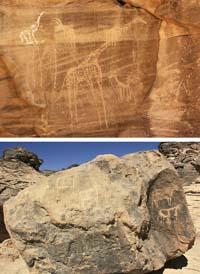Seller of desertification
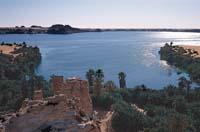
To learn how climate change occurred in one place, in this case in the Sahara, it would be best to have data on temperatures and rainfall for thousands of years. The devices that measure them, however, we invented them relatively recently and we only have data of the last hundred years. Therefore, scientists have had to look for indirect ways to know the conditions of previous epochs. The study of ocean and lake sediments is due, among other things, to the continuous reception of terrestrial materials (grains of sand transported by the wind, pollen grains) in thin layers. The study of these thin layers allows, therefore, to go back in time and know the conditions of different times, as is done with the study of the rings of the trees.
To analyze the change produced in the Sahara, we should go back at least 6,000 years, since those who say the change was rapid, since about 5,500 years ago desertification. They have been based on sediments collected in the Atlantic Ocean to protect the most widespread idea currently. Among other things, they have seen that at that time the amount of sand that came suddenly from the Sahara increased greatly.
However, the use of seabed sediments as a source of information has the problem that it is not known which area or geographical area the accumulated sediments belong to. For this purpose, the sediments of the lakes are more precise, since they collect materials from much smaller areas.
Six thousand years ago there were lakes in the Sahara, which kept information in the sediments, but most of the information until more than 4,000 years ago, from there many dried up and stopped storing orderly.
Therefore, these ancient lagoons do not serve to reconstruct the climatology of the last millennia and to complete information coming from the ocean. The sea is, therefore, the only tool that climatologists have to know the history of the Sahara in this period.
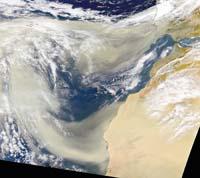
However, despite the passage of time and that the Sahara has become a desert, there is a lake that has not dried up: Yoa Lagoon. Located north of Chad, it has had water in the last 11.500 years. It is currently in a hyper-dry area, with annual water losses due to evaporation, but is fed by an old underground aquifer that has not been dried. Therefore, since its birth, materials from nearby lands have been accumulated.
Living Witness
In this lagoon was carried out the study of the team that has published the article in the journal Science. They obtained a lot of information through cross-channel channels. On the one hand, the variation of the precipitation frequency in the area has been interpreted through the temporal variation of the salinity of the lagoon, analyzing the remains of water diatoms and invertebrates that inhabited each time.
On the other hand, they have seen how the vegetation surrounding the lagoon has changed over time, observing the pollen that accumulated in the sediments. And finally, the minerals of the sediments (sand) have been analyzed to see how the wind regimes changed and what was the degree of coverage of the plants in each epoch in the adjacent areas (the smaller the vegetation, the greater the amount of sand moves in an area due to the large capacity of retention of the plants).
As for salinity, it is observed that it passed relatively quickly from being a freshwater lagoon to being a very salty water ecosystem. In fact, they have discovered that living freshwater beings have fallen rapidly (both in phytoplankton species and in insects and microcrustaceans) and were replaced by organisms that live in increasingly salty waters.
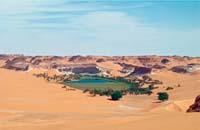
According to the researchers, the polynical record of the lacustrine sediments has been reflected in the process of disappearance of the savannah plants and the appearance of desert plants: until 4,300 years ago the Sahara was dominated by the savannah, an open area full of herbs with some species of dispersed acacia.
However, 5,600 years ago the vegetation began to change. At this time belong the first semi-planted plants of the Sahara. However, the process accelerated a thousand years later. In fact, they have seen that the arrival of grass pollen to sediments was less and less 4,800-4,300 years ago, and the explanation that has been given to it is that it was then when the grass began to clear.
In addition, the amount of sand of the sediments increased considerably from 3,700 years ago, which indicates that, according to the researchers, the wind began to move a greater amount of sand, that is, the vegetation cover decreased. And semi-amortized plants began to prevail 3.900-3.100 years ago.
The plants of the real deserts, for their part, have been found in sediments of 2,700 years ago, which has allowed to deduce that the desert that we know today arose then.

This progressive substitution of the plants observed in the sediments of the lagoon, described in a period of 2,500 years, would not have been possible if the idea that now shelters the majority was real, that is, if the climate had been altered in a short period of time. For this reason, scientists who have written this article consider that the most widespread theory of the moment must be erroneous.
Difficulties in the study of climate change
In view of all the data provided by these researchers, it seems that they have sufficient indications that desertification around Lake Yoa was slow. But is it possible to extend what happened in this specific field to the rest of the Sahara?
In the opinion of many experts, no, nor do they believe that concrete research like this can provoke a revolution in the way we understand how climate change occurred in North Africa. However, they consider that it has made some interesting contributions, among which are the response of the vegetation to the changes of the environment and the time they take to react to them.
The truth is that no one really knows what happened in the Sahara to move from a green savannah to a dry desert. They produce models from data from diverse sources such as the atmosphere, oceans, surface, living beings, ice and energy of the Sun. These models indicate -- and it seems that most researchers agree -- that changes in the environment of the time were due to a change at the planetary level.
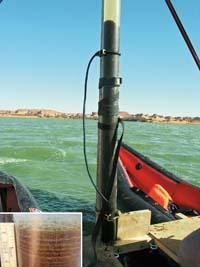
The study of other lagoons of similar characteristics to those of Lake Yoa would help clarify how and for how long this desertification occurred, so that in many places there were available the exact data offered by this lake and, joining the information that all contribute, it would be easier to reconstruct the past. But there is nothing, Lake Yoa is the only one that has survived for so many years in the Sahara (and if there is another, they do not know it...).
